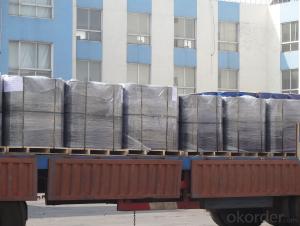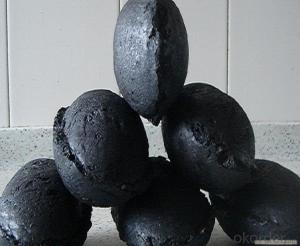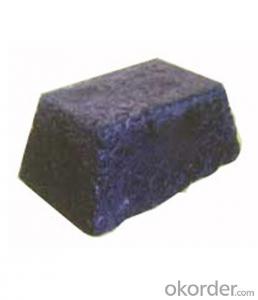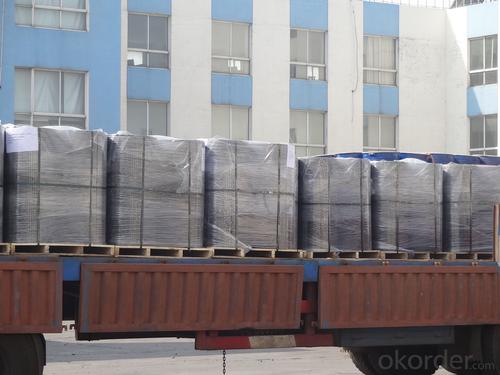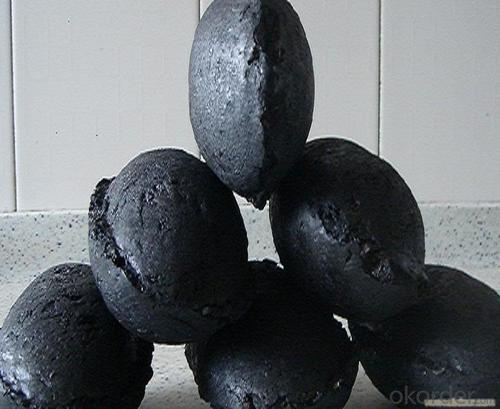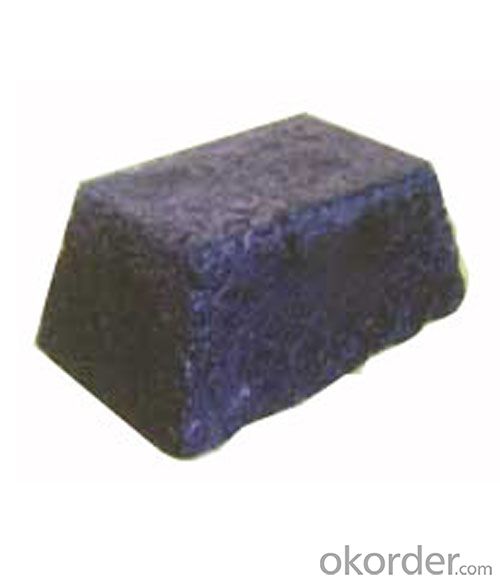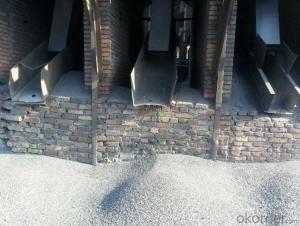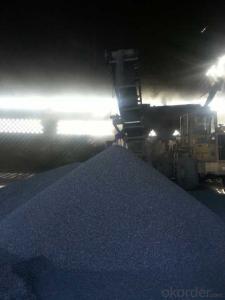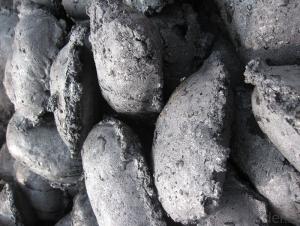Low Ash Carbon Electrode Paste Reasonable Price
- Loading Port:
- Tianjin
- Payment Terms:
- TT OR LC
- Min Order Qty:
- 0 m.t.
- Supply Capability:
- 20000 m.t./month
OKorder Service Pledge
OKorder Financial Service
You Might Also Like
Specifications
Specification/Item |
|
|
|
|
|
|
Ash | 4.0%max | 5.0%max | 6.0%max | 7.0% Max | 9.0% Max | 11.0% Max |
VM | 12.0%-15.5% | 12.0%-15.5% | 12.0%-15.5% | 9.5.0%-13.5% | 11.5%-15.5% | 11.5%-15.5% |
Compress Strength | 18.0Mpa Min | 17.0Mpa Min | 15.7Mpa Min | 19.6Mpa Min | 19.6Mpa Min | 19.6Mpa Min |
Specific Resistance | 65μΩm Max | 68μΩm Max | 75μΩm Max | 80μΩm Max | 90μΩm Max | 90μΩm Max |
Bulk Density | 1.38G/CM3 Min | 1.38G/CM3 Min | 1.38G/CM3 Min | 1.38G/CM3 Min | 1.38G/CM3 Min | 1.38G/CM3 Min |
Main Function And Features
1) Low ash content
2) Good electric and thermal conductivity
3) High resistance to temperature
4) Stable quality
5) Reasonable price
6) Size:all kinds of electrode paste
7) Accord customer's reques change
Introduction To Products
1) Carbon Electrode Paste is a self-baking electrode used in submerged arc furnaces for delivering power to the charge mix.
2) Electrode Paste is added to the top of the electrode column in either cylindrical or briquette form.
3) As the paste moves down the electrode column the temperature increase causes the paste to melt and subsequently bake
forming a block of electrically conductive carbon.
4) Electrode Paste is essentially a mix of Electrically Calcined Anthracite (ECA) or Calcined Petroleum Coke (CPC) with Coal
Tar Pitch.
Application Range
1) Be used as the electrode for self roasting in the iron-alloy furnace and acetylene furnace.
2) Amorphous graphite powder--applied in steel making,fireproof material,casting coating.
3) Calcined petroleum coke--used in foundry,metallurgy,carbon paste,graphite electrode.
4) Carbon anode scrap--used as smelting fuel for copper smelting industry.
5) Carbon electrode paste--applied in iron alloy,calcium carbide,ferroalloy,ferromanganese.
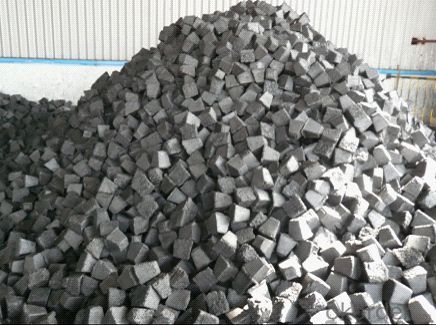
- Q: What should we do to reduce carbon emissions in our lives?
- Reducing the burning of fossil fuels is important, reducing the emission of motor vehicles, reducing private cars, reducing thermal power, and burning carbon emissions from coal-fired power plants
- Q: What are the carbon nanotube applications?
- The hydrogen storage materials: gas adsorption in adsorption is a solid adsorbent surface behavior the occurrence process of adsorbent and solid surface characteristics are closely related. The adsorption mechanism of nanoparticles, it was generally accepted that adsorption of carbon nanotubes is mainly due to the surface hydroxyl carbon nanotubes nanoparticles. The effect of carbon nanotubes on the surface of to hydroxyl and certain cationic bonding, so as to achieve the apparent of metal ions or organic matter adsorption. In addition, carbon nanotube particles have a large surface area, is also an important reason for the adsorption of carbon nanotubes. Zheng Qingrong, Gu Anzhong and [4] were studied on the adsorption behavior of hydrogen in carbon nanotubes Cheng Hui Ming et al. Synthesis of SWNTS treated properly can store hydrogen at room temperature, the hydrogen storage weight of up to 4.2%, and 78.3% of the hydrogen storage under normal temperature and pressure The hydrogen is released, and the remaining hydrogen is released after heating. The SWNTS can be reused and has a high commercial valueThe proton exchange membrane fuel cell (PEM) is a new type of carbon nanotubes: fuel cell vehicle power supply the most potential, the fuel cell through the consumption of hydrogen to generate electricity, the exhaust gas discharged into water vapor, therefore no pollution. It is compared with the lithium ion battery and Ni MH battery has great superiority. Can use carbon nanotubes hydrogen storage material supply hydrogen, can also be through the decomposition of oil and gas and other hydrocarbons or directly from the air to obtain hydrogen fuel cell hydrogen source.
- Q: Appearance, hardness, electrical conductivity, use of carbon 60
- C60 does not normally conduct electricity because C60 is so large that it can put other atoms into it and affect its physical properties, so it cannot be electrically conductiveUsed to strengthen metalImprove the metal material strength by alloying, plastic deformation and heat treatment, one of the ways to strengthen the interaction through geometry, such as coke carbon dispersed in the metal, carbon and metal exchange position in the crystal lattice, can cause plastic deformation of metal, carbon and metal carbide particles that can make the metal enhanced. In the enhancement of metal materials, the effect of C60 ratio of carbon in coke is better, this is because the C60 is higher than the smaller particles, active carbon, particle size of C60 with metal carbide dispersion effect is 0.7nm, and the particle size of carbon and metal carbide dispersion effect the body is 2 m ~ 5 m, has a larger difference in enhancing the role of the metal.Used as a new catalystIn C60, the electronic structure of chemists began to explore the possibility of.C60 catalyst for C60 with olefin, with transition metal (such as platinum and nickel metal) to form a series of complexes. For example C60 and platinum, osmium can be combined into {[(C2H5) 3P]2Pt}C60 and C60OsO4 (four butylpyridine) and other coordination compounds and they are likely to become the efficient catalyst.Japanese researchers Toyohashi University of science and technology of the synthesis of highly catalytic activity of palladium Pt synthesis researchers and C60 compound C60Pd6. China Wuhan University (PPh3) 2C60 (PPh3 three, triphenylphosphine) for hydrosilylation reaction with high catalytic activity.
- Q: How does carbon affect the formation of acid rain?
- Carbon does not directly affect the formation of acid rain. Acid rain is primarily caused by emissions of sulfur dioxide and nitrogen oxides, which react with water, oxygen, and other chemicals in the atmosphere to form sulfuric acid and nitric acid. However, carbon dioxide, a greenhouse gas emitted from the burning of fossil fuels, contributes to climate change. Climate change can alter weather patterns and increase the frequency and intensity of precipitation, which can indirectly affect the acidity of rain.
- Q: What are the effects of carbon emissions on the Arctic ecosystem?
- Carbon emissions have significant effects on the Arctic ecosystem, primarily due to the phenomenon of global warming. As carbon dioxide and other greenhouse gases are released into the atmosphere, they trap heat, leading to increased temperatures worldwide. However, the Arctic is particularly vulnerable to these effects due to its unique characteristics. One of the most significant impacts of carbon emissions on the Arctic ecosystem is the rapid melting of ice. Rising temperatures cause glaciers and ice sheets to shrink, leading to the loss of habitat for ice-dependent species such as polar bears, walruses, and seals. These animals not only rely on the ice for resting and breeding but also for hunting and finding food. With the reduction of their natural habitat, their populations are declining, impacting the delicate balance of the Arctic food chain. Additionally, the melting of ice results in rising sea levels, which can have cascading effects on coastal areas. Many Arctic communities, including indigenous peoples, are located near the coast and depend on the sea for their livelihoods. Increased erosion, flooding, and storm surges due to rising sea levels threaten their homes, infrastructure, and traditional ways of life. Furthermore, carbon emissions contribute to ocean acidification, a process in which the absorption of excess carbon dioxide by seawater leads to a decrease in its pH level. This acidification has detrimental effects on marine organisms such as shellfish, corals, and plankton, which struggle to build and maintain their calcium carbonate structures. These organisms are essential food sources for various Arctic species, including fish, seabirds, and marine mammals. The decline in their populations disrupts the intricate web of life in the Arctic and can have far-reaching consequences. Climate change caused by carbon emissions also disrupts the timing and patterns of seasonal events, such as the timing of plant growth, the migration of birds, and the availability of food resources. This mismatch can have severe consequences for species that rely on specific timing for reproduction, migration, and survival. Overall, the effects of carbon emissions on the Arctic ecosystem are profound and wide-ranging. The loss of sea ice, rising sea levels, ocean acidification, and disrupted ecological processes all contribute to the vulnerability of Arctic species and communities. Urgent action to reduce carbon emissions, mitigate climate change, and protect this fragile ecosystem is crucial for the long-term preservation of the Arctic.
- Q: How is carbon used in the medical field?
- Carbon is used in various ways in the medical field due to its unique properties. One of the most common applications of carbon is in the form of activated charcoal, which is widely used in hospitals to treat cases of poisoning or drug overdoses. Activated charcoal has a large surface area, allowing it to adsorb toxins and chemicals, preventing them from being absorbed into the bloodstream. Carbon is also utilized in medical imaging techniques such as positron emission tomography (PET) scans. In PET scans, a radioactive form of carbon, known as carbon-11, is used to label molecules such as glucose. This labeled carbon is then injected into the patient, and its distribution in the body is detected by a PET scanner. This technique helps in the diagnosis and monitoring of various diseases, including cancer, by visualizing metabolic activity in different organs and tissues. Furthermore, carbon-based materials, such as carbon nanotubes and graphene, are extensively studied for their potential applications in drug delivery systems. These materials can be modified to carry therapeutic agents, such as drugs or genes, and deliver them to specific targets in the body. Carbon nanotubes, in particular, have shown promising results in enhancing drug delivery efficiency and reducing side effects. Moreover, carbon is used in the manufacturing of medical devices and implants. Carbon fiber-reinforced polymers are employed in orthopedic implants and prosthetics due to their strength, flexibility, and biocompatibility. Carbon-based materials also play a crucial role in the production of electrodes for various medical devices like pacemakers, defibrillators, and neurostimulators. In summary, carbon finds numerous applications in the medical field, ranging from treating poisonings to enhancing diagnostic imaging techniques, drug delivery systems, and the production of medical devices. It continues to be an essential component in advancing medical technology and improving patient care.
- Q: How does carbon affect the ozone layer?
- The ozone layer is not directly affected by carbon. However, the depletion of the ozone layer can be indirectly contributed to by certain carbon compounds, such as chlorofluorocarbons (CFCs) and hydrochlorofluorocarbons (HCFCs). When these compounds break down due to sunlight, chlorine and bromine atoms are released into the atmosphere. Once in the atmosphere, chlorine and bromine atoms can destroy ozone molecules catalytically, resulting in a thinning of the ozone layer. When a chlorine or bromine atom encounters an ozone molecule, it reacts with and breaks it apart, forming a chlorine or bromine oxide molecule and a regular oxygen molecule. The chlorine or bromine oxide molecule can then react with another ozone molecule, continuing the cycle and depleting the ozone layer. Although carbon in itself does not directly contribute to ozone depletion, the production and release of carbon compounds like CFCs and HCFCs are a result of human activities. These compounds were extensively used in various industries, such as refrigeration, air conditioning, and aerosol propellants, until their harmful effects on the ozone layer were discovered. To address this issue, the Montreal Protocol, an international treaty signed in 1987, aimed to phase out the production and use of these ozone-depleting substances. However, reducing carbon emissions is essential in addressing another environmental concern – climate change. The atmosphere's high levels of carbon dioxide and other greenhouse gases trap heat, leading to global warming. This poses various threats to ecosystems and human societies. By transitioning to cleaner and more sustainable energy sources and implementing measures to reduce carbon emissions, we can effectively tackle both ozone depletion and climate change, thereby safeguarding the health of our planet.
- Q: How does carbon contribute to the strength of alloys?
- Carbon contributes to the strength of alloys by forming interstitial solid solutions with metals, which increases the hardness and strength of the material. The carbon atoms occupy the spaces between the metal atoms, creating lattice distortions and enhancing the overall strength of the alloy. Additionally, carbon can also form compounds with metals, such as carbides, which further improve the hardness and wear resistance of alloys.
- Q: What is carbon pricing?
- Carbon pricing refers to a policy mechanism that aims to reduce greenhouse gas emissions by assigning a monetary value to carbon dioxide and other greenhouse gas emissions. It essentially puts a price on the carbon content of fossil fuels and other activities that release greenhouse gases into the atmosphere. The main objective of carbon pricing is to incentivize businesses, industries, and individuals to reduce their carbon emissions by making it more economically viable to adopt cleaner and more sustainable practices. There are two primary methods of carbon pricing: carbon taxes and cap-and-trade systems. A carbon tax sets a fixed price per ton of carbon emissions, which businesses and industries must pay based on their emissions levels. This tax creates a financial incentive for companies to reduce their emissions to avoid higher costs. On the other hand, cap-and-trade systems set a limit, or cap, on the total amount of emissions allowed in a given period. Companies are then allocated a certain number of emissions permits, which they can buy, sell, or trade with other companies. This system creates a market for emissions, where companies that can reduce their emissions more easily can sell their surplus permits to those struggling to meet their targets. The revenue generated from carbon pricing can be used in various ways. It can be reinvested into renewable energy projects, energy efficiency initiatives, or research and development of clean technologies. It can also be used to support vulnerable communities affected by the transition to a low-carbon economy or to offset the economic impacts on industries that may face challenges in reducing their emissions. Carbon pricing is considered an effective tool for tackling climate change, as it provides a clear economic signal to businesses and individuals to reduce their carbon footprint. By placing a price on carbon, it internalizes the costs associated with climate change and encourages the adoption of cleaner alternatives. It also helps to level the playing field between polluting industries and those investing in low-carbon technologies, creating an incentive for innovation and the development of sustainable practices.
- Q: What are carbapenem antibiotics?
- The home has been listed on the varieties of imipenem, meropenem, panipenem, faropenem, ertapenem, biapenem.Carbapenem antibiotics are the most widely antibacterial and atypical antibiotics with the strongest antibacterial activity.
Send your message to us
Low Ash Carbon Electrode Paste Reasonable Price
- Loading Port:
- Tianjin
- Payment Terms:
- TT OR LC
- Min Order Qty:
- 0 m.t.
- Supply Capability:
- 20000 m.t./month
OKorder Service Pledge
OKorder Financial Service
Similar products
Hot products
Hot Searches
